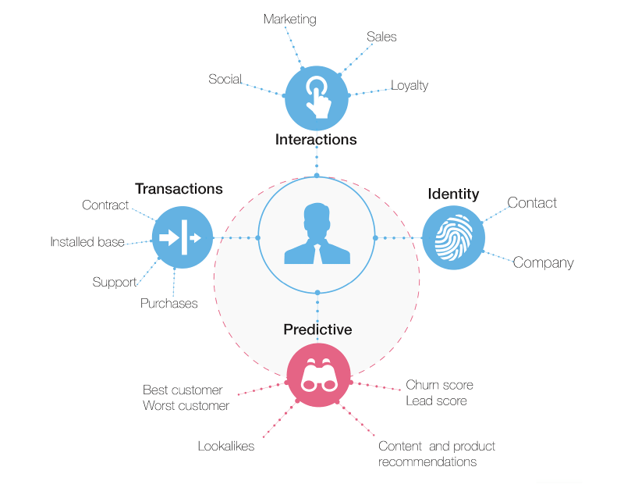“What elements need to be in place before starting predictive marketing?” We get asked this question a lot. Predictive marketing is all about data, so a better question is, “How do I make sure that all the relevant tools and platforms generate high-quality data?”
Not sure what predictive marketing is? Learn more: Introduction to Predictive Marketing Analytics

Graphic: Customer profile including predictive scores.
Here is a checklist of the system capabilities and operational principles that can help you improve the quality of your data:
- Capture interaction data from all touchpoints. Predictive marketing data needs to reflect the actual customer journey. Collecting data is easier in the digital world, but you should also put in place mechanisms to capture IRL (in-real-life) events like store visits and encounters with potential customers at trade shows, events, CRM activities and so on.
- Tie interactions to a cookie or email. Without an identity–an actual person–there is no one to directly communicate with. Visitor (cookie based) communication is limited to website and webstore personalization and ad targeting. Then, when they submit a webform, the cookie and all related interactions can be tied to a contact email. Keep in mind that this can get quite complicated when contacts use multiple devices, sometimes even multiple browsers, from many locations with different IP addresses. Identity stitching tools or functions solve this challenge.
- Tie contacts to a company. If you cannot assign a contact to a company, their value for B2B business is very limited. Once a contact submits a webform with their company name, this task is easy. But you can and should match contacts to their company before knowing exactly who they are: find out their IP address and then use reverse-IP lookup to map them to a company. This is especially important in Account-Based Marketing (ABM) where some of the buying team members might never submit a webform.
- Maintain and enrich master data. Keep your more static contact and company data in good shape (up-to-date, accurate, no duplicates, etc.) and enrich it with information that can be used in segmentation and lead prioritization. This includes contact data like job title and firmographics like industry classification and company size. You also need to enrich customer data with predictive attributes like leads score or churn propensity.
- Capture critical conversion points. There are five touchpoints or moments in the customer journey that you absolutely need to capture: first touch, lead capturing, opportunity creation, deal closing, and retention. If you can pinpoint the customer, marketing, or sales action that preceded each of these conversion points, you have a good game plan for converting your next customer. Once customers enter your digital domain (Marketing Automation Platform and CRM = the last four touchpoints) this becomes easier, but you can only analyze the effectiveness of the first touchpoint by tagging all your marketing channels and campaigns (display ads, social media, referral web pages, third-party apps etc.).
- Do not manually touch or manipulate your data. Data extraction and transformation must be done using scripts because manual handling may reduce its quality. Unless you are the data scientist responsible for ETL (and if you don’t know what this means, this is probably not you), do not aggregate data or transform the data in any way. Don’t manipulate data by hand (in Excel or anywhere else if you can possibly avoid it).
- Enrich with sales and contract data. At minimum, you should have these three pieces of information for each customer: 1. total revenue during the past year, 2. the number of sales transactions (or the number of subscriptions) during that year, and 3. the date of their latest purchase. If you are in B2B business, you should also get basic contract data also. Installed base data with commissioning dates gives you the ability to pinpoint extended warranty and spare parts opportunities.
While this might sound like a lot of work, your company is most likely already doing most of these things. You simply need to make contacts with the right people in your company in order to get access to this data and make sure the principles listed above are being followed.
There is no better way to get to know your customers than Predictive Marketing. And those companies that know their customers the best will win the game in the long run.
Customer Insight and Engagement
Explore our white paper to build a system of insight for better customer engagement.
Download nowMatti is an expert in customer feedback management, marketing automation, predictive marketing analytics, and how to use data and machine learning to automatically trigger customer interactions. Before joining TietoEVRY, Matti worked for a customer feedback analysis company Etuma and before that Nokia in the U.S.